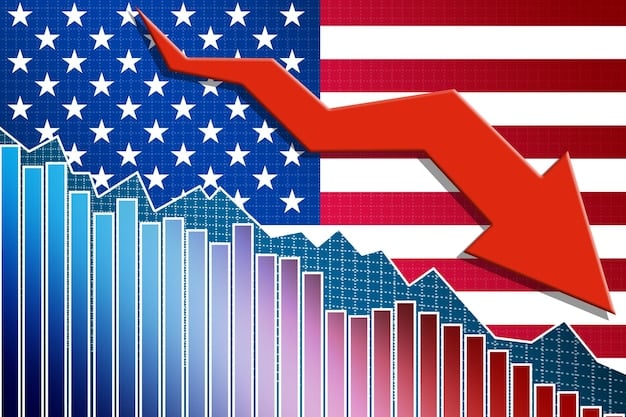New Corporate Tax Rate 2025: Impact on US Business Investments

The forecasted new corporate tax rate for 2025 in the US is poised to significantly reshape business investment decisions, potentially influencing capital allocation, mergers and acquisitions, and overall economic growth projections as companies adjust financial strategies to optimize post-tax returns.
As the business landscape continually evolves, a pressing question arises for American enterprises: Is the New Corporate Tax Rate Impacting US Business Investments in 2025? This complex query delves into the intricate relationship between fiscal policy and corporate behavior, a dynamic that profoundly influences job creation, innovation, and global competitiveness. Understanding this interplay is crucial for businesses, investors, and policymakers alike.
Understanding the Current US Corporate Tax Landscape
Before delving into the potential impacts of a new corporate tax rate in 2025, it’s essential to grasp the current tax environment. The United States has a history of fluctuating corporate tax policies, each change carrying significant implications for businesses operating within its borders. Presently, the federal corporate income tax rate stands at 21%, a figure established by the Tax Cuts and Jobs Act (TCJA) of 2017.
This rate marked a substantial reduction from the previous 35%, a move largely aimed at making the US more competitive internationally and stimulating domestic investment. The TCJA also introduced other provisions, such as full expensing for certain capital investments, designed to encourage immediate business spending. However, the economic outcomes of these changes have been debated, with some economists pointing to moderate increases in investment and others highlighting their limited impact on wage growth or overall GDP.
Historical Context of US Corporate Taxation
To fully appreciate the potential shifts, a brief historical overview is beneficial. Prior to the TCJA, the US had one of the highest statutory corporate tax rates among developed nations. This often led to discussions about corporate inversions, where companies would relocate their legal domicile to lower-tax jurisdictions to reduce their tax burden. The policy aimed to mitigate these tendencies and retain corporate profits within the US economy.
- Pre-TCJA (Prior to 2018): Federal corporate tax rate at 35%, often cited as a competitive disadvantage.
- TCJA (2018 onwards): Rate reduced to 21%, with additional provisions like accelerated depreciation.
- Economic Rationale: Boost domestic investment, encourage repatriation of foreign profits, and enhance global competitiveness.
Understanding this trajectory helps set the stage for how businesses might react to future tax adjustments. The memory of previous significant changes, and their varied effects, influences corporate decision-making and forecasting for 2025.
The current tax structure is not static. Various deductions, credits, and state-level taxes further complicate the picture, creating a multifaceted tax burden for corporations. While the federal rate is a primary driver, the cumulative effect of all tax obligations is what ultimately shapes a company’s financial health and its capacity for investment. Policy discussions often revolve around finding a balance between generating government revenue and fostering a conducive environment for business expansion.
Proposed Changes to Corporate Tax Rates for 2025
Discussions around altering the corporate tax rate for 2025 are gaining momentum, primarily driven by evolving economic priorities and budgetary considerations. While no concrete legislation has been passed, several proposals are on the table, each with distinct implications for businesses and the broader economy. These proposals typically emanate from different political factions, reflecting varied philosophies on fiscal policy and economic stimulus.
One prominent proposal suggests an increase in the federal corporate income tax rate, potentially reversing some of the TCJA’s reductions. Proponents of such a move often argue that it would increase government revenue, which could then be used to fund public investments in infrastructure, education, or social programs. They might also contend that higher corporate taxes contribute to a fairer distribution of wealth and reduce income inequality, arguing that the benefits of the TCJA disproportionately favored shareholders and executives.
Key Proposals Under Discussion
Several figures and approaches have been floated in policy circles:
- Moderate Increase (e.g., to 25% or 28%): This approach aims to strike a balance between increased revenue and maintaining competitiveness. It seeks to avoid a drastic shock to the business community while still addressing budgetary needs.
- Progressive Tax Structure: Some proposals suggest a tiered system where larger corporations or those with higher profits face a higher marginal tax rate. This is intended to target companies deemed capable of bearing a larger tax burden without significantly impeding smaller businesses or startups.
- Minimum Corporate Tax: Another concept is a global minimum corporate tax, often discussed in international forums. This would compel multinational corporations to pay a baseline tax rate regardless of where their profits are booked, potentially reducing incentives for profit shifting.
Each of these proposals carries unique administrative complexities and economic projections. Businesses are closely monitoring these discussions, as the specifics of any new tax regime will dictate their strategic responses.
Beyond the headline rate, proposed changes often include adjustments to deductions, credits, or international tax rules. For instance, there might be renewed focus on limiting offshoring incentives or introducing new tax breaks for specific types of domestic investment, such as green energy or critical infrastructure projects. These ancillary provisions could be just as impactful as the rate itself, influencing where and how companies choose to invest their capital. The debate is multifaceted, weighing the need for revenue against the desire for economic growth and international competitiveness.
Economic Theories on Corporate Tax Impact
The relationship between corporate taxation and business investment is a cornerstone of economic theory, yet it remains a subject of considerable debate. Economists generally agree that corporate taxes influence investment decisions, but they often diverge on the magnitude and channels of that influence. Understanding these theoretical underpinnings is crucial for predicting how a new corporate tax rate might affect US businesses in 2025.
One primary theory, often associated with neoclassical economics, posits that corporate taxes reduce the after-tax return on investment (ROI). When the ROI is lower, businesses are less incentivized to undertake new projects, expand operations, or purchase new equipment. This perspective suggests a direct, negative correlation: higher taxes lead to less investment. The argument builds on the idea that firms will only invest if the expected returns exceed their cost of capital, and taxes diminish those returns.

Channels of Impact on Investment
Corporate taxes can influence investment through several mechanisms:
- Cost of Capital: Taxes increase the effective cost of raising capital for new projects, making fewer projects appear profitable.
- Retained Earnings: Higher taxes reduce the amount of profit a company can retain, limiting internally generated funds available for reinvestment.
- Location Decisions: Companies may opt to invest in countries with lower tax rates, shifting capital away from high-tax jurisdictions.
However, other economic perspectives offer a more nuanced view. Some argue that the impact of corporate taxes on investment is not as straightforward as the neoclassical model suggests. Factors such as consumer demand, technological innovation, regulatory environment, and access to skilled labor can also significantly influence investment decisions, sometimes outweighing the direct effect of tax rates. For example, a company might invest heavily in a market with strong growth prospects even if tax rates are relatively high, provided other conditions are favorable.
Modern economic research also considers the “incidence” of corporate taxes – who ultimately bears the burden of the tax. While companies nominally pay the corporate tax, some economists argue that a portion of the tax burden is passed on to consumers through higher prices, to workers through lower wages, or to shareholders through reduced dividends. If the burden is primarily borne by consumers or workers, the impact on corporate investment might be less direct than if it falls solely on the firm’s profits. This complexity means that even a well-intentioned tax change can have unforeseen consequences across different segments of the economy, making precise predictions challenging.
Potential Impacts on US Business Investment by 2025
The prospect of a new corporate tax rate in 2025 introduces a significant variable into the strategic planning of US businesses. The potential impacts on investment decisions are multifaceted, extending beyond mere capital expenditure to influence broader corporate behavior, including mergers and acquisitions, research and development, and even human capital investments. Enterprises are already beginning to model various scenarios to prepare for these changes.
If the corporate tax rate increases, a likely initial reaction from some businesses could be a reevaluation of high-cost, long-term capital projects. Projects that were marginally profitable under the 21% rate might no longer meet the internal rate of return (IRR) thresholds required for approval. This could lead to a slowdown in certain types of physical investment, such as new factory construction or significant equipment upgrades. Companies might also become more selective, prioritizing only those investments with the strongest and most immediate returns.

Broader Business Implications
- Capital Expenditure Slowdown: Less attractive ROI for certain long-term, high-cost projects.
- Increased Shareholder Distributions: Companies might favor returning capital to shareholders through buybacks or dividends if reinvestment opportunities become less appealing due to higher taxes.
- Shift in Investment Focus: Potentially a move towards less capital-intensive investments, such as software development or intellectual property, or away from the US.
- R&D and Innovation: The impact on R&D is mixed; some argue higher taxes deter risk-taking, others say targeted tax credits could mitigate this.
Conversely, if the new tax regime includes targeted incentives—for instance, accelerated depreciation for specific types of equipment or tax credits for investment in particular regions or sectors (e.g., green technology or domestic manufacturing)—this could partially offset the disincentive of a higher headline rate. Such provisions would channel investment towards politically favored areas, potentially distorting market allocations but achieving policy goals. Businesses would then adjust their strategies to capitalize on these new incentives, potentially shifting investment patterns rather than reducing overall investment.
The psychological impact on business confidence cannot be overstated. Uncertainty regarding future tax policies can itself deter investment, as companies prefer stability and predictability in their operating environment. Clear, long-term tax policy signals are often valued more by businesses than short-term fluctuations, even if those fluctuations temporarily offer lower rates. Therefore, the manner in which any new tax rate is introduced—its perceived permanence and transparency—will significantly influence corporate responses in 2025 and beyond.
Industry-Specific Analysis: Vulnerabilities and Opportunities
A new corporate tax rate will not impact all US business sectors uniformly. Different industries, by their very nature, have varying capital expenditure needs, profit margins, and exposure to international markets, making them more or less vulnerable to shifts in fiscal policy. Analyzing these industry-specific dynamics is crucial for a comprehensive understanding of the 2025 tax environment.
Capital-intensive industries, such as manufacturing, heavy industry, and utilities, are often among the most sensitive to changes in corporate tax rates. These sectors rely heavily on large, long-term investments in plant, property, and equipment, which are directly affected by modifications to depreciation rules or overall tax burdens. A higher tax rate could disproportionately deter investment in these areas, potentially slowing modernization or expansion. Conversely, tax incentives aimed at manufacturing or infrastructure could greatly benefit them, driving significant investment.
Sectoral Variances in Tax Impact
Consideration must be given to how specific industries might react:
- Technology and Services: Often less capital-intensive, relying more on human capital and intellectual property. Might be less impacted by direct capital expensing changes, but a higher overall rate could reduce funds for R&D or talent acquisition. International tax aspects (e.g., global minimum tax) could also significantly affect their global profit structures.
- Retail and Consumer Goods: Heavily influenced by consumer demand. While corporate taxes affect their profitability, their investment decisions (e.g., new store openings, inventory management) are more directly tied to consumer spending trends.
- Financial Services: Highly regulated and globalized. Tax changes could influence their lending activities, investment banking, and cross-border transactions. Potential for shifting tax burdens onto consumers of financial products.
- Healthcare and Pharmaceuticals: Often have substantial R&D investments. Targeted tax credits for R&D could partially offset a higher general corporate tax rate, influencing where these companies conduct their research.
Export-oriented industries, or those that compete globally, also face unique challenges. A higher US corporate tax rate, if not mirrored by similar increases abroad, could diminish their international competitiveness. This might lead them to reconsider the location of future investments, potentially diverting capital out of the US in favor of lower-tax jurisdictions. Conversely, industries primarily serving the domestic market might be less concerned with international tax arbitrage and more focused on domestic demand and specific US tax incentives.
Ultimately, the specific details of any new tax legislation will determine the nuanced impact on each sector. Policymakers must carefully weigh these industry-specific vulnerabilities and opportunities to avoid unintended consequences and ensure a balanced economic outcome. Businesses, in turn, are analyzing their unique tax sensitivities to formulate adaptive strategies for 2025.
Policy Alternatives and Mitigating Measures
Recognizing the potential impact of corporate tax changes on business investment, policymakers often explore a range of alternatives and mitigating measures to balance revenue generation with economic growth. These tools can be deployed strategically to shape investment behavior, even in the context of a higher headline corporate tax rate. The goal is often to stimulate desired economic activity while ensuring fiscal responsibility.
One common alternative is to couple any increase in the corporate income tax rate with targeted tax incentives for investment. For example, accelerated depreciation rules could be enhanced, allowing businesses to deduct a larger portion of their capital expenditures in the year they are incurred. This significantly reduces the immediate tax burden on new investments, making them more attractive despite a higher general corporate tax rate. Similarly, investment tax credits for specific types of equipment or for projects in designated economic zones can channel capital to areas where policy wants to encourage growth, such as clean energy or underserved communities.
Tools for Policy Mitigation
- Research and Development (R&D) Credits: Expanding or enhancing tax credits for R&D expenses to encourage innovation, even if the general corporate tax rate rises. These credits can be particularly impactful for technology and pharmaceutical sectors.
- Investment Tax Credits (ITCs): Providing direct credits for specific capital investments, often tied to job creation or sustainability goals. These can be powerful levers for directing capital.
- Depreciation Allowances: Adjusting methods for deducting the cost of assets over time, such as offering immediate expensing or more rapid depreciation schedules, effectively lowers the cost of capital.
- Reduced Rates for Small Businesses: Creating a tiered system where smaller businesses or startups face lower tax rates to foster entrepreneurship and growth in the SME sector.
Another crucial mitigating measure involves clarity and predictability in tax policy. Businesses thrive on certainty, and a transparent, long-term tax framework—even if it entails a higher rate—is often preferred over frequent, unpredictable changes. Policymakers can provide this certainty by clearly outlining the rationale for tax changes, their expected duration, and any accompanying incentives. This allows businesses to plan and commit to long-term investments without the constant fear of sudden shifts that could undermine their profitability projections.
Furthermore, international tax reforms, such as the implementation of a global minimum tax, could help level the playing field, reducing the incentive for companies to shift profits or operations overseas solely for tax purposes. This could allow for a higher domestic corporate tax rate without significantly eroding the US’s international competitiveness. The interplay of domestic and international tax policies is complex, and a holistic approach considering both is essential for effective mitigation.
Preparing US Businesses for 2025 Tax Changes
Given the strong likelihood of corporate tax rate discussions and potential changes influencing US business investments in 2025, proactive preparation is not merely advisable but essential. Companies that strategically assess their positions, model various scenarios, and adapt their financial and operational plans will be better positioned to navigate the evolving tax landscape and maintain competitiveness. Delaying preparation can lead to missed opportunities or unexpected financial burdens.
The first step for any business is a thorough tax strategy review. This involves analyzing current tax liabilities, identifying potential areas of exposure under different proposed tax regimes, and understanding how existing tax credits and deductions might be affected. Engaging with tax advisors and legal counsel is paramount in this phase, as they can provide tailored insights based on a company’s unique structure, industry, and investment portfolio. This review should encompass not just federal taxes but also state and local tax implications, as these can also shift in response to federal changes.
Key Preparatory Steps for Businesses
- Scenario Modeling: Develop financial models to simulate the impact of different corporate tax rates (e.g., 25%, 28%) on profitability, cash flow, and return on investment for various projects.
- Capital Allocation Review: Re-evaluate planned capital expenditures, mergers, and acquisitions. Prioritize projects that offer strong returns even under potentially higher tax burdens. Consider accelerating or deferring investments based on the timing of proposed changes.
- Supply Chain and Location Strategy: For multinational corporations, assess the tax implications of global supply chains and manufacturing locations. Higher US taxes might affect transfer pricing strategies and the location of intellectual property.
- Digital Transformation and Efficiency: Invest in technologies that enhance operational efficiency and reduce costs, as these improvements can bolster profitability regardless of tax rate changes.
Beyond internal financial adjustments, businesses should also actively engage in advocacy. Participating in industry associations and communicating with policymakers can help shape the legislative debate, ensuring that business perspectives are heard. Providing data and insights on the practical impacts of proposed tax changes can influence the final policy, potentially leading to more favorable outcomes or mitigating harsh provisions.
Finally, fostering a culture of adaptability and continuous monitoring is crucial. The tax landscape is dynamic, and what is proposed today may evolve significantly before 2025. Businesses that routinely scan the horizon for policy shifts, adjust their internal models, and remain agile in their financial planning will be best equipped to not only survive but thrive amidst an altered corporate tax environment.
| Key Point | Brief Description |
|---|---|
| 📊 Tax Rate Debate | Proposals for 2025 include increases, progressive structures, and minimum taxes. |
| 📉 Investment Impact | Higher taxes can reduce ROI, potentially slowing capital expenditure and R&D. |
| 💡 Industry Nuances | Capital-intensive sectors are more sensitive; tech may be less affected by direct capex changes. |
| 🛠️ Mitigation & Prep | Targeted tax incentives, policy clarity, and proactive business modeling are crucial. |
Frequently Asked Questions About 2025 Corporate Tax Rates
While there are ongoing discussions and proposals for an increased corporate tax rate in 2025, no legislation has been finalized. The exact nature and timing of any changes remain subject to political negotiations and economic conditions. Businesses should stay updated on legislative developments as 2025 approaches.
A flat rate increase affects all, but large corporations with extensive capital investments or international operations may feel a greater impact on large-scale projects. Small businesses could be disproportionately affected if they lack the resources for complex tax planning or cannot easily absorb higher costs without passing them on to consumers. Some proposals consider tiered rates or specific relief for SMEs.
Yes, a significantly higher US corporate tax rate, especially if not aligned with global trends, could incentivize some multinational companies to shift investments or even operations to lower-tax jurisdictions. This is particularly relevant for highly mobile intellectual property and service-based industries. International agreements, like a global minimum tax, aim to mitigate this risk.
Long-term, large-scale capital expenditures, such as building new factories, purchasing heavy machinery, or undertaking extensive infrastructure projects, are often most sensitive. These investments have long payback periods and are highly influenced by the after-tax return on investment (ROI). Research and development (R&D) outlays can also be significantly affected if not offset by specific R&D tax credits.
Businesses should conduct comprehensive tax strategy reviews, model various tax scenarios, and re-evaluate their capital allocation plans. Engaging with tax experts, staying informed about policy discussions, and considering the acceleration or deferral of investments based on potential effective dates are crucial preparatory steps. Fostering operational efficiency will also provide a cushion against increased tax burdens.
Conclusion
The question of whether a new corporate tax rate will impact US business investments in 2025 is not a matter of if, but how extensively and in what specific areas. The historical context and economic theories underscore the fundamental link between fiscal policy and corporate behavior. While the headline rate is a crucial factor, the nuanced details of any new tax legislation—including accompanying incentives, depreciation allowances, and international tax reforms—will ultimately shape investment decisions. Businesses, from capital-intensive manufacturers to innovative tech firms, are already beginning to assess their vulnerabilities and opportunities. Proactive planning, scenario modeling, and an adaptive mindset will be paramount for navigating the evolving tax landscape, ensuring both compliance and continued growth in the dynamic economic environment of 2025.





